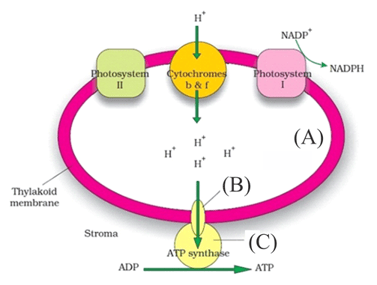HARD
Earn 100
Draw the schematic diagram of the process of ATP synthesis through chemiosmosis in chloroplast.
Important Questions on Photosynthesis
EASY
MEDIUM
Assertion A: During photophosphorylation protons are transported across the membrane and accumulated inside the lumen.
Reason R: To develop proton gradient, pheophytin transfers electrons to hydrogen carriers instead of electron carrier.
EASY
Which of the following are required for chemiosmosis?
I. A membrane
I. A neutron pump
II. An electron gradient
IV.
The correct answer is:
MEDIUM
MEDIUM
EASY
EASY
HARD
EASY
MEDIUM
Statement I: In photosynthesis, during ATP synthesis, protons accumulate in the lumen of thylakoid.
Statement II: In respiration, during ATP synthesis, protons accumulate in the intermembranal space of mitochondria.
EASY
EASY
EASY
MEDIUM
EASY
EASY
MEDIUM
Identify the parts marked as and in the given figure showing ATP synthesis through chemiosmosis.
** Options were incomplete and changes were made accordingly.
EASY
MEDIUM
EASY

